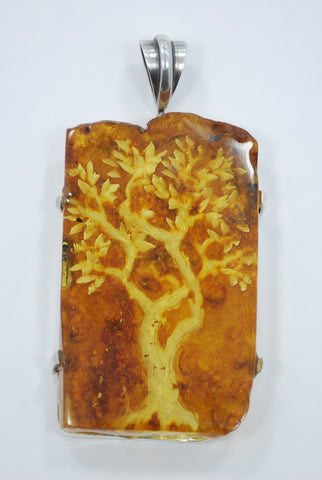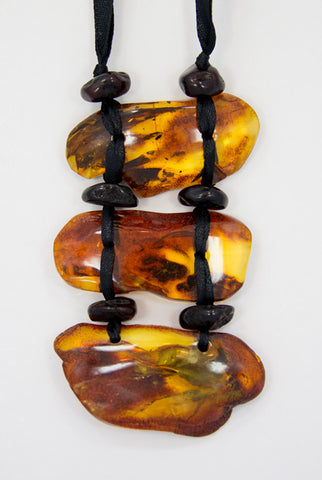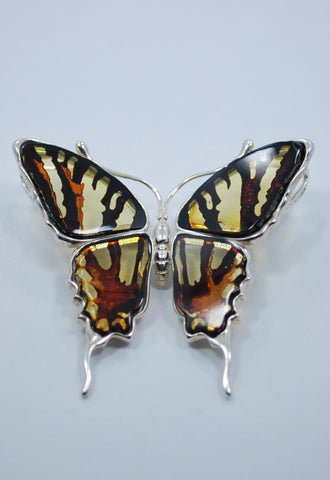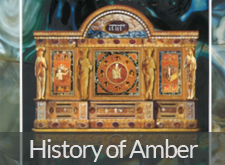History of Amber
 Story as told by Paul Harvey on "The Rest of the Story" and Cynthia Rutledge.
Story as told by Paul Harvey on "The Rest of the Story" and Cynthia Rutledge.
GENUINE IMITATION AMBER
A young couple from the Midwest decided to spend their honeymoon in California. They enjoyed the weather and walking along the boardwalks with all of the small shops. In one of the shops they found a case with a sign saying "Genuine Imitation" next to a display of beautiful necklaces. The wife looked through the selection and found one that she really loved. It was a bit pricey, but the husband wanted to buy his bride a memento of the honeymoon trip so they left the store with an amber colored necklace of carved beads.
The necklace was a favorite and she wore it on many occasions, always thinking of their honeymoon when she did. After 20+ years the necklace finally broke. She took it to her local jeweler to ask if he could restring it for her. He said that it should not be a problem and took out his loop to look at the beads. While still examining the necklace he asked if she would be willing to sell it and offered her $1,000 for it. She very indignantly said "No - it was a gift from my husband, and anyway why would you pay $1,000 for imitation beads?" The jeweler did not answer her question, but did restring the necklace as she requested.
When she returned home, her husband was just as surprised as she was at the jewelers' offer. He was planning a business trip to New York City and told his wife that he would take the necklace along and if he had time he would stop at one of the famous jewelry stores there and see if they would appraise it for him. He did get time to stop at a jewelry store while he was in New York and they did agree to look at the necklace for him. The jeweler promptly asked him if he wanted to sell the piece and offered him $3,000 for it. The husband said, "Please tell me what is going on, why would someone offer us $1,000 and then $3,000 for a necklace made up of genuine imitation beads? I do not understand" To which the jeweler replied "You have never looked at these beads with a loop, have you?"
"Of course not, why would we?" replied the husband. The jeweler then went on to explain that the beads were actually carved amber, not imitation anything, and that each of the beads was inscribed: To Josephine from Napoleon 18xx.
AMBER ROOM
While many Americans associate amber with the casing for dinosaur DNA in 1993's Jurassic Park, the stone has enthralled Europeans, and especially Russians, for centuries because of the golden, jewel-encrusted Amber Room, which was made of several tons of the gemstone. A gift to Peter the Great in 1716 celebrating peace between Russia and Prussia, the room's fate became anything but peaceful: Nazis looted it during World War II, and in the final months of the war, the amber panels, which had been packed away in crates, disappeared. A replica was completed in 2003, but the contents of the original, dubbed "the Eighth Wonder of the World," have remained missing for decades.
Golden Gift
Construction of the Amber Room began in 1701. It was originally installed at Charlottenburg Palace, home of Friedrich I, the first King of Prussia. Truly an international collaboration, the room was designed by German baroque sculptor Andreas Schlüter and constructed by the Danish amber craftsman Gottfried Wolfram. Peter the Great admired the room on a visit, and in 1716 the King of Prussia—then Frederick William I—presented it to the Peter as a gift, cementing a Prussian-Russian alliance against Sweden.
The Amber Room was shipped to Russia in 18 large boxes and installed in the Winter House in St. Petersburg as a part of a European art collection. In 1755, Czarina Elizabeth ordered the room to be moved to the Catherine Palace in Pushkin, named Tsarskoye Selo, or "Czar's Village." Italian designer Bartolomeo Francesco Rastrelli redesigned the room to fit into its new, larger space using additional amber shipped from Berlin.
After other 18th-century renovations, the room covered about 180 square feet and glowed with six tons of amber and other semi-precious stones. The amber panels were backed with gold leaf, and historians estimate that, at the time, the room was worth $142 million in today's dollars. Over time, the Amber Room was used as a private meditation chamber for Czarina Elizabeth, a gathering room for Catherine the Great and a trophy space for amber connoisseur Alexander II.
Nazi Looting
On June 22, 1941, Adolf Hitler initiated Operation Barbarossa, which launched three million German soldiers into the Soviet Union. The invasion led to the looting of tens of thousands of art treasures, including the illustrious Amber Room, which the Nazis believed was made by Germans and, most certainly, made for Germans.
As the forces moved into Pushkin, officials and curators of the Catherine Palace attempted to disassemble and hide the Amber Room. When the dry amber began to crumble, the officials instead tried hiding the room behind thin wallpaper. But the ruse didn't fool the German soldiers, who tore down the Amber Room within 36 hours, packed it up in 27 crates and shipped it to Königsberg, Germany (present-day Kaliningrad). The room was reinstalled in Königsberg's castle museum on the Baltic Coa The museum's director, Alfred Rohde, was an amber aficionado and studied the room's panel history while it was on display for the next two years. In late 1943, with the end of the war in sight, Rohde was advised to dismantle the Amber Room and crate it away. In August of the following year, allied bombing raids destroyed the city and turned the castle museum into ruins. And with that, the trail of the Amber Room was lost.
Conspiracies, Curses and Construction
It seems hard to believe that crates of several tons of amber could go missing, and many historians have tried to solve the mystery. The most basic theory is that the crates were destroyed by the bombings of 1944. Others believe that the amber is still in Kaliningrad, while some say it was loaded onto a ship and can be found somewhere at the bottom of the Baltic Sea. In 1997, a group of German art detectives got a tip that someone was trying to hawk a piece of the Amber Room. They raided the office of the seller's lawyer and found one of the room's mosaic panels in Bremen, but the seller was the son of a deceased soldier and had no idea as to the panel's origin. One of the more extreme theories is that Stalin actually had a second Amber Room and the Germans stole a fake.
Another bizarre aspect of this story is the "Amber Room Curse." Many people connected to the room have met untimely ends. Take Rohde and his wife, for example, who died of typhus while the KGB was investigating the room. Or General Gusev, a Russian intelligence officer who died in a car crash after he talked to a journalist about the Amber Room. Or, most disturbing of all, Amber Room hunter and former German soldier Georg Stein, who in 1987 was murdered in a Bavarian forest.
The history of the new Amber Room, at least, is known for sure. The reconstruction began in 1979 at Tsarskoye Selo and was completed 25 years—and $11 million—later. Dedicated by Russian President Vladimir Putin and then-German Chancellor Gerhard Schröder, the new room marked the 300-year anniversary of St. Petersburg in a unifying ceremony that echoed the peaceful sentiment behind the original. The room remains on display to the public at the Tsarskoye Selo State Museum Reserve outside of St. Petersburg.
Photo by: Marek Zak
Genuine Imitation Amber
Reprint from Dee’s Place website with the permission from Doris Coghill
Amber Room
Reprint from : http://www.smithsonianmag.com/history-archaeology/world-history/brief_amber.html#ixzz2ceoerzap














